Influence of Hydrophobic Fin Configuration in Thermal System in Relation to Electronic Device Cooling Applications
Abstract
1. Introduction
2. Heating and Flow Analysis
2.1. Governing Equations
2.2. Boundary Conditions
2.3. Numerical Implementation
2.4. Mesh Generation
2.5. Thermo-Physical Properties
2.6. Model Validation
3. Results and Discussion
4. Conclusions
Author Contributions
Funding
Acknowledgments
Conflicts of Interest
Nomenclature
| c | Specific heat (J/kgK) |
| CP | Pressure loss factor |
| g | Gravity (m/s2) |
| k | Thermal conductivity (W/mK) |
| Ls | Slip length (m) |
| LT | Thermal resistance length (m) |
| n | Fin count |
| Nu | Nusselt number |
| P | Pressure (kPa) |
| Pr | Prandtl number |
| Re | Reynold number |
| T | Temperature (K) |
| Ts | Liquid temperature at wall interface (K) |
| Tw | Solid wall temperature at interface (K) |
| Vs | Slip velocity (m/s) |
| ∂u/∂n | Rate of fluid strain on slip surface (1/s) |
| V | Velocity vector (m/s) |
| Greek letters | |
| ε | Strain rate tensor (1/s) |
| β | Volumetric thermal expansion coefficient (1/K) |
| μ | Viscosity (Pa.s) |
| ϕ | Temperature parameter |
| Φ | Viscous dissipation (1/s2) |
| ρ | Density (kg/m3) |
| Subscripts | |
| max | maximum |
| min | minimum |
| ref | reference |
References
- Qian, M.; Li, J.; Xiang, Z.; Yan, C.; Hu, X. Effect of Pin Diameter Degressive Gradient on Heat Transfer in a Microreactor with Non-Uniform Pin-Fin Array under Low Reynolds Number Conditions. Energies 2019, 12, 2702. [Google Scholar] [CrossRef]
- Shyu, J.-C.; Chang, T.; Lee, S.-C. A Numerical Study on Natural Convection Heat Transfer of Handheld Projectors with a Fin Array. Energies 2017, 10, 266. [Google Scholar] [CrossRef]
- Tijani, A.S.; Jaffri, N.B. Thermal analysis of perforated pin-fins heat sink under forced convection condition. Procedia Manuf. 2018, 24, 290–298. [Google Scholar] [CrossRef]
- Li, D.; Yang, C.; Yang, H. Experimental and numerical study of a tube-fin cool storage heat exchanger. Appl. Therm. Eng. 2019, 149, 712–722. [Google Scholar] [CrossRef]
- Shaalan, M.R.; Saleh, M.A.; Mesalhy, O.; Elsayed, M.L. Thermo/fluid performance of a shielded heat sink. Int. J. Therm. Sci. 2012, 60, 171–181. [Google Scholar] [CrossRef]
- Chang, S.W.; Su, L.M.; Yang, T.L.; Chiou, S.F. Enhanced heat transfer of forced convective fin flow with transverse ribs. Int. J. Therm. Sci. 2004, 43, 185–200. [Google Scholar] [CrossRef]
- Hajmohammadi, M.; Ahmadian, M.; Nourazar, S. Introducing highly conductive materials into a fin for heat transfer enhancement. Int. J. Mech. Sci. 2019, 150, 420–426. [Google Scholar] [CrossRef]
- Tu, J.; Yuen, W.; Gong, Y. An Assessment of Direct Chip Cooling Enhancement Using Pin Fins. Heat Transf. Eng. 2012, 33, 845–852. [Google Scholar] [CrossRef]
- Reddy, S.; Abdoli, A.; Dulikravich, G.S.; Pacheco, C.C.; Vasquez, G.; Jha, R.; Colaço, M.J.; Orlande, H.R.B. Multi-Objective Optimization of Micro Pin-Fin Arrays for Cooling of High Heat Flux Electronics with a Hot Spot. Heat Transf. Eng. 2016, 38, 1235–1246. [Google Scholar] [CrossRef]
- Duan, L.; Liu, B.; Qi, B.; Zhang, Y.; Wei, J. Pool boiling heat transfer on silicon chips with non-uniform micro-pillars. Int. J. Heat Mass Transf. 2020, 151, 119456. [Google Scholar] [CrossRef]
- So, H.; Pisano, A.P. Self-Transport of Condensed Liquid in Micro Cooling Device Using Distributed Meniscus Pumping. Langmuir 2015, 31, 6588–6594. [Google Scholar] [CrossRef] [PubMed]
- Oguntala, G.; Abd-Alhameed, R.; Sobamowo, G.M.; Abdullahi, H.-S. Improved thermal management of computer microprocessors using cylindrical-coordinate micro-fin heat sink with artificial surface roughness. Eng. Sci. Technol. Int. J. 2018, 21, 736–744. [Google Scholar] [CrossRef]
- Ganesan, P.B.; Vanaki, S.M.; Thoo, K.; Chin, W. Air-side heat transfer characteristics of hydrophobic and super-hydrophobic fin surfaces in heat exchangers: A review. Int. Commun. Heat Mass Transf. 2016, 74, 27–35. [Google Scholar] [CrossRef]
- Guan, N.; Jiang, G.; Liu, Z.; Zhang, C.; Liang, X. The impact of contact angle on flow resistance reduction in hydrophobic micro pin fins. Exp. Therm. Fluid Sci. 2016, 77, 197–211. [Google Scholar] [CrossRef]
- Wang, F.; Liang, C.; Yang, M.; Zhang, X. Effects of surface characteristics on liquid behaviors on fin surfaces during frosting and defrosting processes. Exp. Therm. Fluid Sci. 2015, 61, 113–120. [Google Scholar] [CrossRef]
- Liang, C.; Wang, F.; Lu, Y.; Yang, M.; Zhang, X. Experimental and theoretical study of frost melting water retention on fin surfaces with different surface characteristics. Exp. Therm. Fluid Sci. 2016, 71, 70–76. [Google Scholar] [CrossRef]
- Rahimi, M.; Afshari, A.; Fojan, P.; Gurevich, L. The effect of surface modification on initial ice formation on aluminum surfaces. Appl. Surf. Sci. 2015, 355, 327–333. [Google Scholar] [CrossRef]
- Yang, Y.; Zhuang, D.; Ding, G. Effect of surface wettability of fins on dust removal by condensate water. Int. J. Heat Mass Transf. 2019, 130, 1260–1271. [Google Scholar] [CrossRef]
- Leslie, G.; Schneider, R.; Fane, A.; Marshall, K.; Fell, C. Fouling of a microfiltration membrane by two Gram-negative bacteria. In Colloids in the Aquatic Environment; Elsevier: London, UK, 1993; pp. 165–178. [Google Scholar]
- Sun, C.; Feng, X. Enhancing the performance of PVDF membranes by hydrophilic surface modification via amine treatment. Sep. Purif. Technol. 2017, 185, 94–102. [Google Scholar] [CrossRef]
- Wang, K.; Hou, D.; Wang, J.; Wang, Z.; Tian, B.; Liang, P. Hydrophilic surface coating on hydrophobic PTFE membrane for robust anti-oil-fouling membrane distillation. Appl. Surf. Sci. 2018, 450, 57–65. [Google Scholar] [CrossRef]
- Wang, Z.; Lin, S. The impact of low-surface-energy functional groups on oil fouling resistance in membrane distillation. J. Membr. Sci. 2017, 527, 68–77. [Google Scholar] [CrossRef]
- Edalatpour, M.; Liu, L.; Jacobi, A.; Eid, K.; Sommers, A. Managing water on heat transfer surfaces: A critical review of techniques to modify surface wettability for applications with condensation or evaporation. Appl. Energy 2018, 222, 967–992. [Google Scholar] [CrossRef]
- Guan, N.; Liu, Z.; Jiang, G.; Zhang, C.; Liang, X. Experimental and theoretical investigations on the flow resistance reduction and slip flow in super-hydrophobic micro tubes. Exp. Therm. Fluid Sci. 2015, 69, 45–57. [Google Scholar] [CrossRef]
- Dilip, D.; Kumar, S.V.; Bobji, M.S.; Govardhan, R.N. Sustained drag reduction and thermo-hydraulic performance enhancement in textured hydrophobic microchannels. Int. J. Heat Mass Transf. 2018, 119, 551–563. [Google Scholar] [CrossRef]
- Shen, C.; Zhang, C.; Bao, Y.; Wang, X.; Liu, Y.; Ren, L. Experimental investigation on enhancement of nucleate pool boiling heat transfer using hybrid wetting pillar surface at low heat fluxes. Int. J. Therm. Sci. 2018, 130, 47–58. [Google Scholar] [CrossRef]
- Ansari, D.; Husain, A.; Kim, K.-Y. Optimization and Comparative Study on Oblique- and Rectangular-Fin Microchannel Heat Sinks. J. Thermophys. Heat Transf. 2010, 24, 849–852. [Google Scholar] [CrossRef]
- Ahmed, H.E.; Salman, B.; Kherbeet, A.; Ahmed, M. Optimization of thermal design of heat sinks: A review. Int. J. Heat Mass Transf. 2018, 118, 129–153. [Google Scholar] [CrossRef]
- Lin, D.T.W.; Kang, C.-H.; Chen, S.-C. Optimization of the Micro Channel Heat Sink by Combing Genetic Algorithm with the Finite Element Method. Inventions 2018, 3, 32. [Google Scholar] [CrossRef]
- Kwak, D.-B.; Kwak, H.-P.; Noh, J.-H.; Yook, S.-J. Optimization of the radial heat sink with a concentric cylinder and triangular fins installed on a circular base. J. Mech. Sci. Technol. 2018, 32, 505–512. [Google Scholar] [CrossRef]
- Tullius, J.F.; Vajtai, R.; Bayazitoglu, Y. A Review of Cooling in Microchannels. Heat Transf. Eng. 2011, 32, 527–541. [Google Scholar] [CrossRef]
- Reddy, S.; Dulikravich, G.S. Inverse Design of Cooling Arrays of Micro Pin-Fins Subject to Specified Coolant Inlet Temperature and Hot Spot Temperature. Heat Transf. Eng. 2016, 38, 1147–1156. [Google Scholar] [CrossRef]
- Comsol Multiphysics. COMSOL INC. 2019. Available online: https://www.comsol.com/ (accessed on 10 February 2020).
- Ou, J.; Rothstein, J.P. Direct velocity measurements of the flow past drag-reducing ultrahydrophobic surfaces. Phys. Fluids 2005, 17, 103606. [Google Scholar] [CrossRef]
- Niu, Y.; Meka, A.; Yang, Y.; Yu, M.; Liu, Y.; Zhang, J.; Yu, C. Understanding the contribution of surface roughness and hydrophobic modification of silica nanoparticles to enhanced therapeutic protein delivery. J. Mater. Chem. B 2016, 4, 212–219. [Google Scholar] [CrossRef]
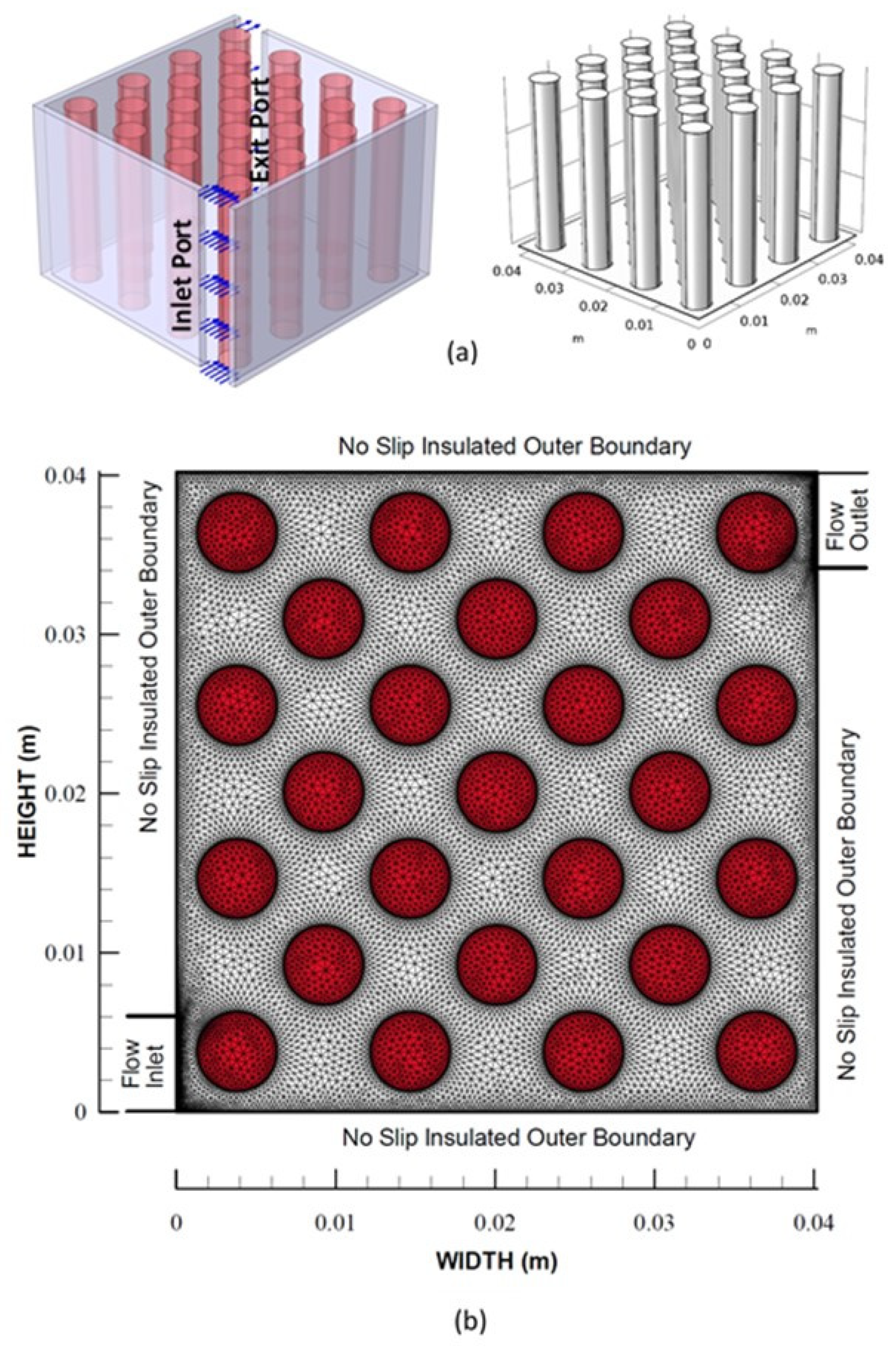

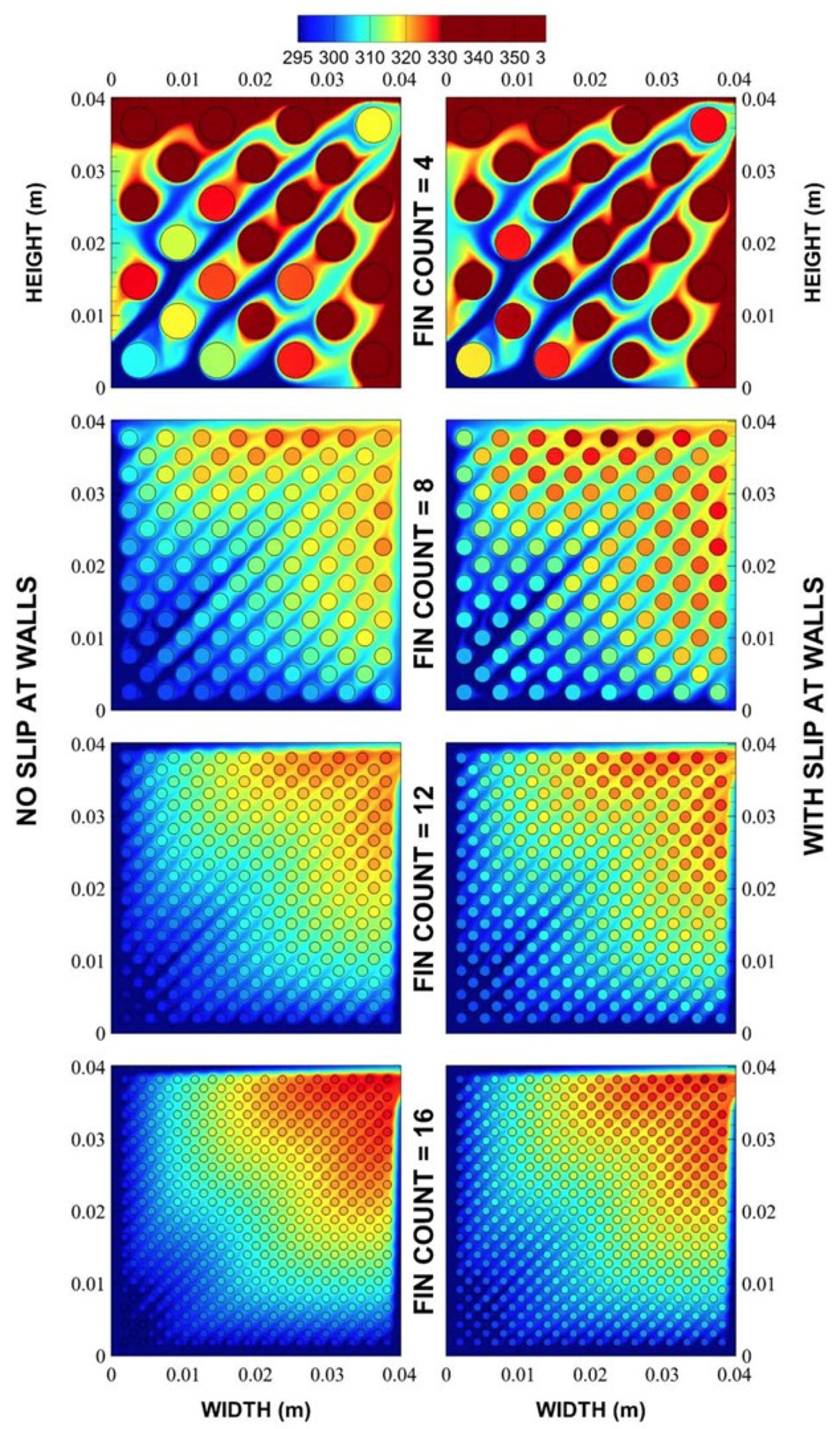


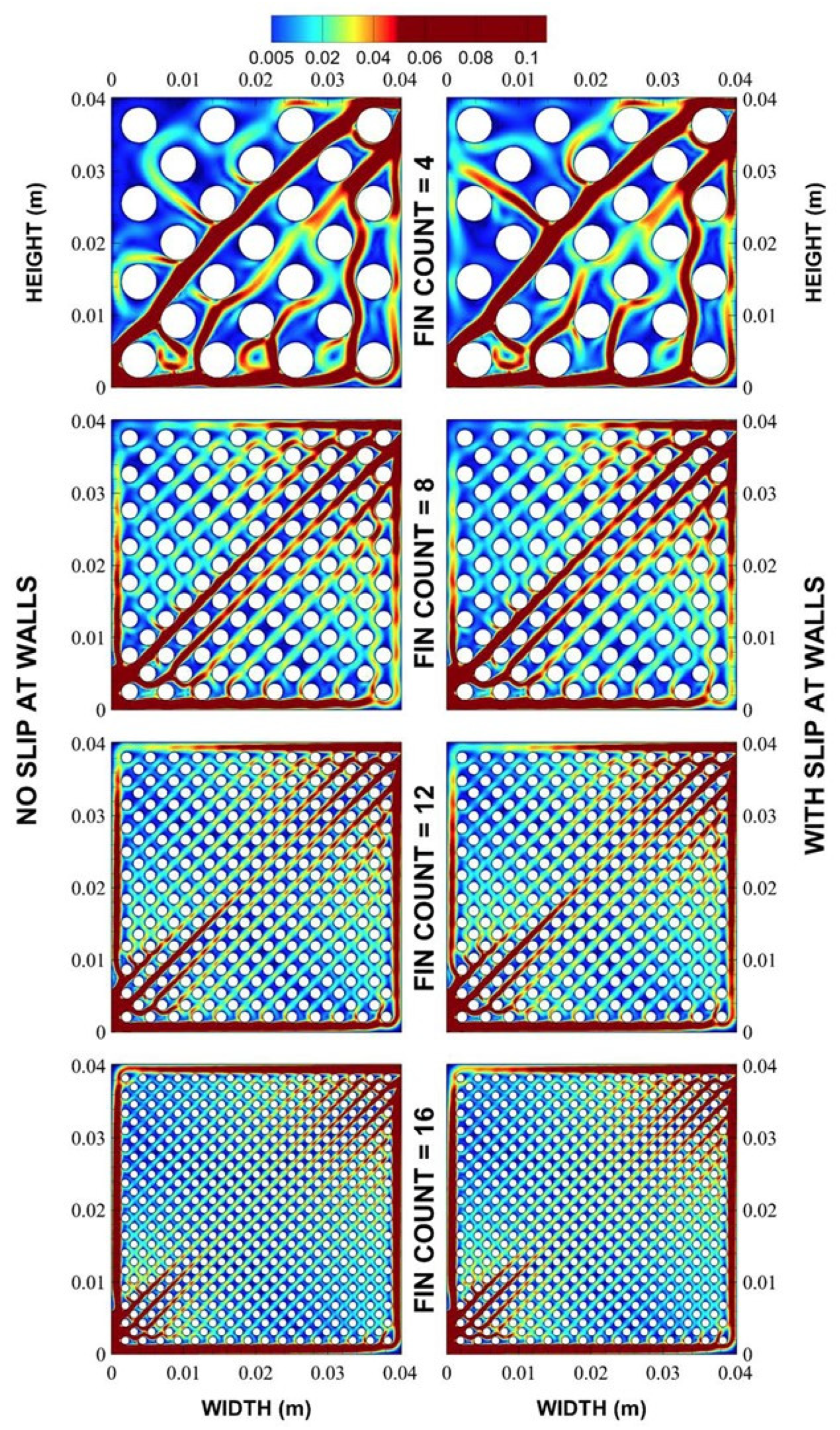

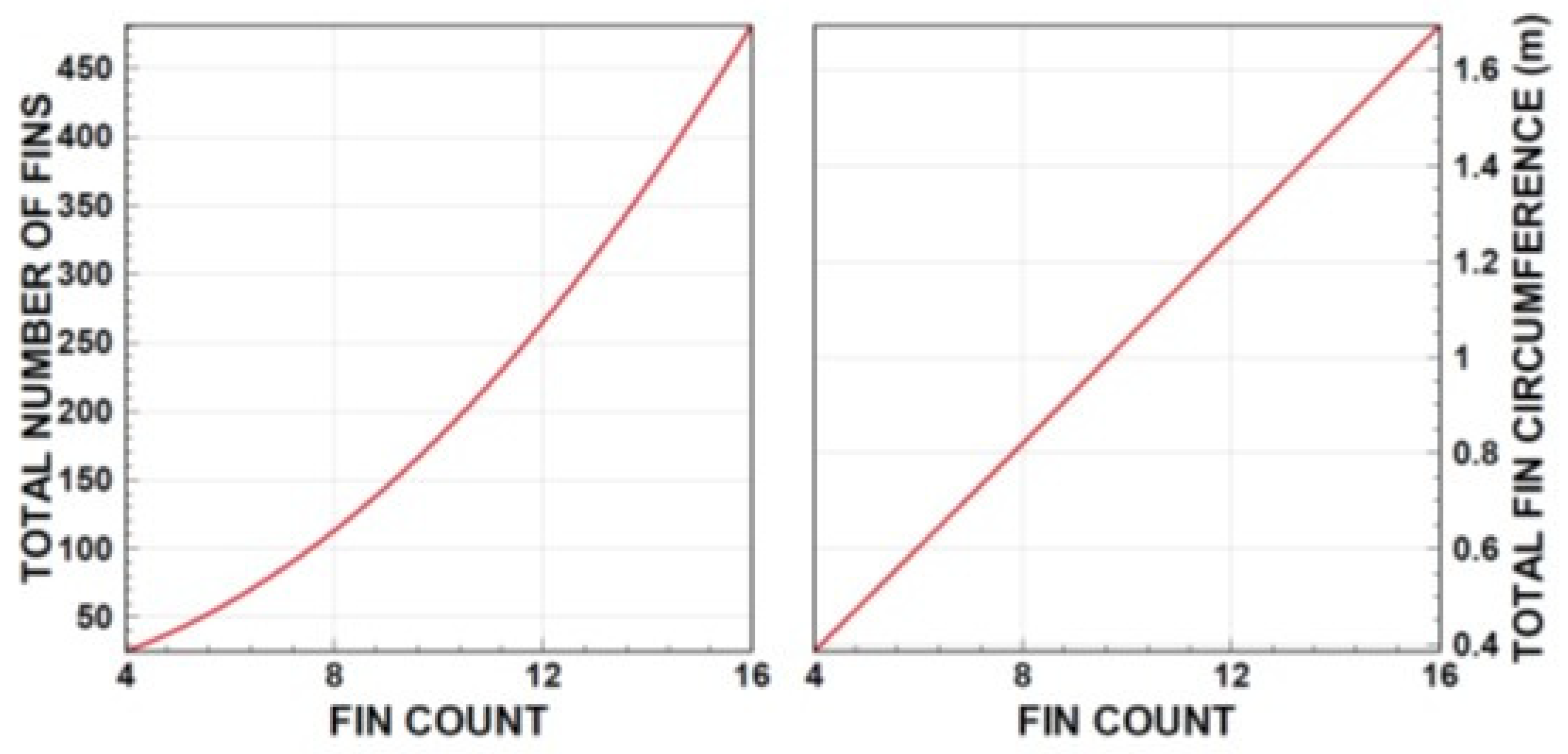
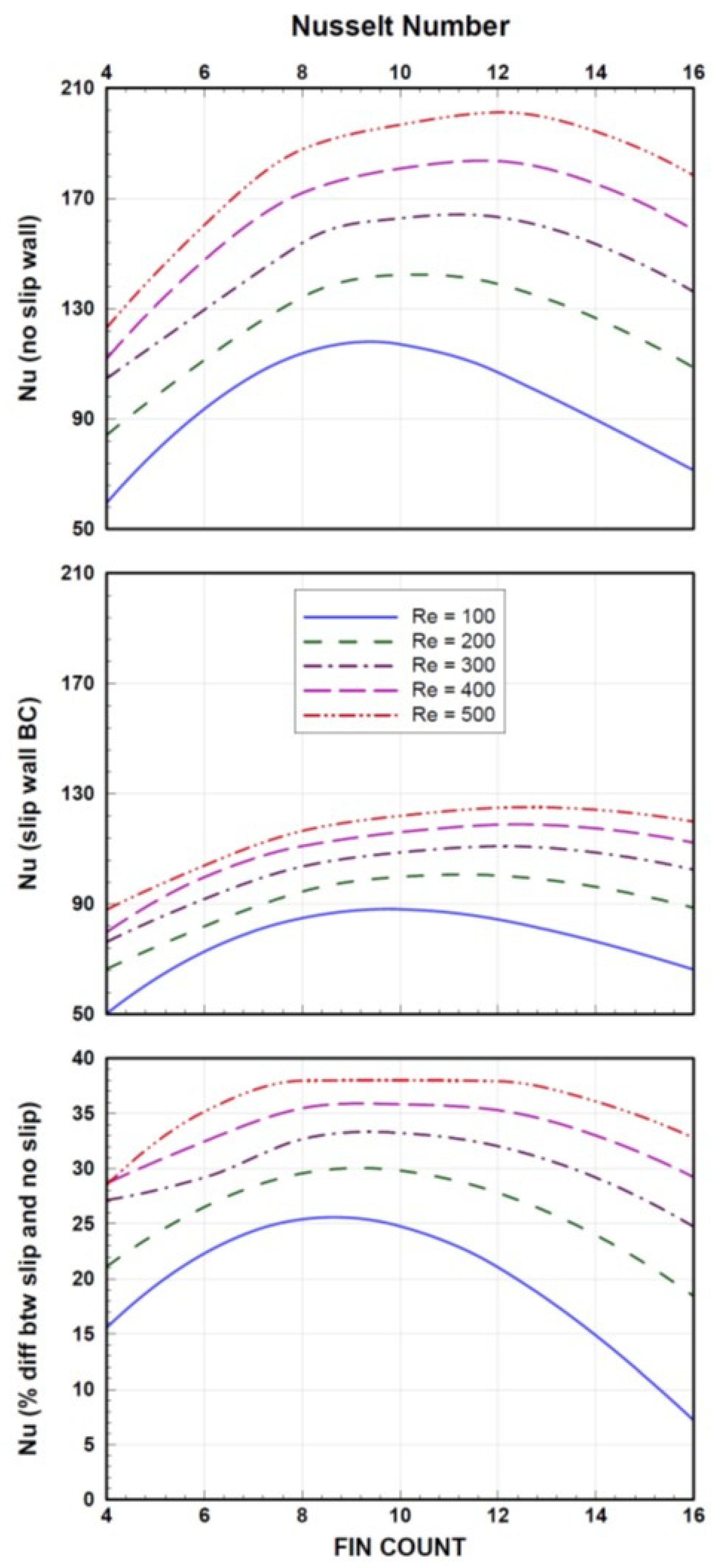

| Property | Value |
|---|---|
| Property | Value |
|---|---|
| 2700 | |
| 900 | |
| 238 |
© 2020 by the authors. Licensee MDPI, Basel, Switzerland. This article is an open access article distributed under the terms and conditions of the Creative Commons Attribution (CC BY) license (http://creativecommons.org/licenses/by/4.0/).
Share and Cite
Shuja, S.Z.; Yilbas, B.S.; Al-Qahtani, H. Influence of Hydrophobic Fin Configuration in Thermal System in Relation to Electronic Device Cooling Applications. Energies 2020, 13, 1631. https://doi.org/10.3390/en13071631
Shuja SZ, Yilbas BS, Al-Qahtani H. Influence of Hydrophobic Fin Configuration in Thermal System in Relation to Electronic Device Cooling Applications. Energies. 2020; 13(7):1631. https://doi.org/10.3390/en13071631
Chicago/Turabian StyleShuja, Shahzada Zaman, Bekir Sami Yilbas, and Hussain Al-Qahtani. 2020. "Influence of Hydrophobic Fin Configuration in Thermal System in Relation to Electronic Device Cooling Applications" Energies 13, no. 7: 1631. https://doi.org/10.3390/en13071631
APA StyleShuja, S. Z., Yilbas, B. S., & Al-Qahtani, H. (2020). Influence of Hydrophobic Fin Configuration in Thermal System in Relation to Electronic Device Cooling Applications. Energies, 13(7), 1631. https://doi.org/10.3390/en13071631





